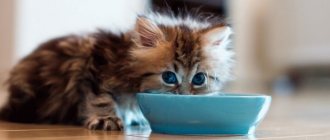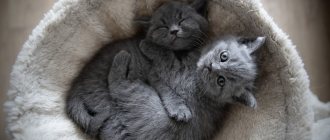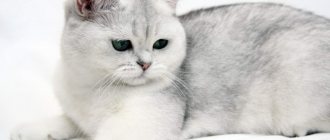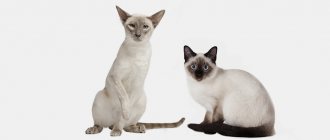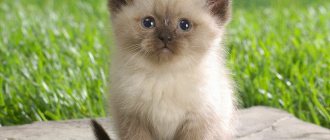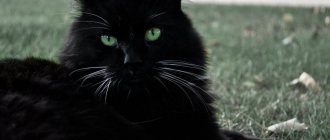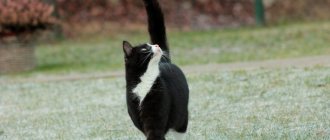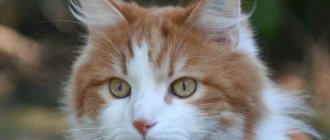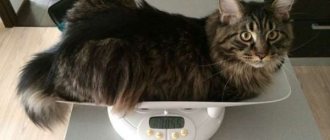It is recommended to study a description of the anatomy of a cat’s body with detailed pictures together with younger family members who are not particularly careful when handling the animal. They learn how fragile these pets are and how easy it is to harm them during active play.
General structure and functions of the cat skeleton
The skeleton of a cat is similar to that of a dog, except for certain distinctive features. It is characterized by a larger number of segments responsible for the plasticity and mobility of the torso of representatives of this family.
The horizontal arrangement of the totality of the bones of the cat’s body determines the special position and shape of each element that forms the bone apparatus. These factors distinguish cats from upright creatures such as humans.
The skeleton of representatives of the cat family includes 40 more segments than the human one. The average number of seeds that form it is from 244 to 250 pieces. These are indicative figures. A number of sources indicate that the number of bones varies between 230–236. This difference in these data is explained by the fact that some bones fused together are considered as a single element.
The length of the animal's tail depends on the number of bones in the cat's skeleton. This organ contains almost 1/10 of all the bones in the cat’s body. On average it contains about 26 vertebrae. The totality of bones in the body of representatives of the cat family has 2 sections: axial and peripheral. The first includes the skull, spine and chest, the second - the limbs.
Nervous system of a cat
The nervous system connects the entire body together and ensures its effective functioning. Nerve fibers are located throughout the animal's body. In response to stimuli, they transmit electrical impulses to the brain and spinal cord.
The central nervous system is divided into several segments:
- Brain.
- Spinal cord.
- Brain stem.
The nerves that are found throughout a cat's body make up the peripheral nervous system. It is she who is responsible for receiving information and transmitting signals to the central nervous system. In addition, it transmits brain commands to different parts of the body.
The autonomic nervous system is a group of nerves that transmit signals to the heart, blood vessels, and bladder. This system operates autonomously; the cat cannot control it consciously.
Kittens are born with an incompletely formed nervous system. They have little control over their body, mostly sleep and eat. In addition, kittens are born blind and deaf. The kitten learns to more or less control its body and stand on its paws around the third week of life. At the same time, the eyes open. Hearing is fully formed by 4 weeks. After another couple of weeks, the kitten begins to actively run and jump.
General information
What is the anatomy of a cat's skeleton? As mentioned above, the animal’s body is divided into regions. In the head there is a face and a skull. The latter contains the anterosuperior part, the crown, the back of the head, the forehead, and the temple. The face is distinguished by the intermaxillary, buccal, orbital, oral, buccal and nasal regions. The cat's neck runs from the back of the head to the shoulder blade. The body is divided into a chest with a corresponding cavity and a back. The mammary glands are located on the chest. The back is divided into two vertebral regions. One is thoracic, the second is interscapular. In the last one on the left, in the area of the elbow joint, there is a cardiac part. The abdomen is divided into posterior, middle and anterior regions.
Animal spine
In the structure of a cat's skeleton, the longest element is the spine. It has incredible flexibility, which is due to the presence of tiny movable bones. This part of the cat's skeleton is formed from many vertebrae, divided into sections such as cervical, thoracic, lumbar, sacral and caudal. Each of them has certain characteristics and deserves special attention.
It is noteworthy that the tail is considered an integral part of the cat's spine. This organ is responsible for maintaining the animal’s balance during jumps and falls.
Cervical region
This section is formed by the larger 7 vertebrae, which are responsible for the support and mobility of the animal’s head. Two of them, called epistropheus (axial, axis) and atlas, are endowed with the unique ability to rotate 180 degrees. These vertebrae are connected to each other by a thin finger-like process.
Due to the increased fragility of such a connecting element, the epistrophy and atlas are considered the most vulnerable parts of the cat’s body, since when injured (impacts, falls from a great height), there is a high probability of damage to the process connecting them, which leads to a fracture of the cervical vertebrae and the death of the animal.
It is for this reason that experts do not recommend using a belt in this part of the cat’s body. Despite its flexibility, the cat's skeleton consists of several extremely fragile elements, which in some cases can be damaged. Under normal conditions, the animal's neck is completely safe. Unlike a belt, a flea collar is completely safe for such a pet.
Chest and ribs
This section of the cat's spine includes 13 vertebrae. 24 rib bones are attached to them on both sides. The first 5 pairs of ribs are called true, because they are attached to the sternum. The remaining ribs, which have an arched shape, are usually called false (false). Thanks to this structure of the rib bones, the flexibility of the animal’s body and its ability to turn around even in conditions of very limited space are ensured.
Digestive and excretory systems
Food enters the cat's stomach through the esophagus. The walls of the esophagus are covered with muscles. They make wave-like movements and push food into the stomach. The stomach of cats is quite spacious. The inside is covered with folds that help chop and digest food. The walls of the stomach secrete acid, which is very important for digestion. Processed food enters the duodenum through the pyloric sphincter.
The duodenum is the first section of the small intestine. The liver and pancreas secrete enzymes that are mixed with food in the duodenum. Next, the food enters the jejunum. It is covered with villi, which are needed to extract all remaining nutrients from food. Next, the food enters the ileum, and then into the large intestine.
The large intestine absorbs fluid from stool. In addition, the large intestine serves to store feces until the animal is ready to defecate. The large intestine consists of the following sections: cecum, colon and rectum.
Excess fluid is removed from the cat’s body through the work of the bladder, ureters and kidneys. In addition, the water-salt balance of the body depends on these organs. Urine is formed in the kidneys and passes through the ureters to the bladder.
A cat is able to control urination thanks to the closing muscle, which retains fluid in the body. Urine exits through the urethra, which in cats ends at the head of the penis, and in cats in the vagina.
Scull
Due to the smaller number of teeth compared to other predators, the cat's skull is characterized by a rounded shape. Its size will depend on belonging to a particular breed or other hereditary characteristics. Representatives of the Persian, exotic and Himalayan breeds are brachycephalic - owners of a shortened skull, which is why they have an abnormal structure of the palate, larynx and trachea. This explains the common problems in these breeds with impaired nasal breathing, snoring and poor tolerance to exercise and heat.
The skull consists of 29 bones, with the brain part being formed from 11, and the facial part from 13 bones. The bones of the skull themselves are larger in size compared to the facial bones. Characteristic features also include large eye sockets and narrowly spaced fangs, adapted for hunting small animals. The main attribute of a predator, which is a cat, is a powerful jaw, which is equipped with different types of teeth. They allow you to grab and hold resisting prey, bite and grind food, and defend yourself if necessary.
Cat's blood circulation
The main organ responsible for blood circulation in a cat’s body is the heart, a hollow muscular organ located in the chest. The ribs and muscles protect it from mechanical damage. The cat's heart consists of 2 ventricles and 2 atria.
Cats have two circles of blood circulation: large and small. Arteries and capillaries come from the heart and penetrate all internal organs. It is through them that all organs are saturated with oxygen - this is a large circle of blood circulation. During the pulmonary circulation, blood saturated with carbon dioxide enters the right ventricle of the heart, from there it is sent to the lungs, where it is again saturated with oxygen and returned to the heart muscle.
By feeling the artery in your cat's thigh, you can measure her pulse. Normally, it is about 100-150 beats per minute in adult animals, and about 150-190 beats per minute in kittens.
You might be interested in: What do black dots in a cat’s fur indicate?
Cat blood has a number of characteristics. It has a higher coagulability compared to humans. Blood consists of the following elements: plasma, red and white blood cells, platelets.
Red blood cells are responsible for saturating the body with oxygen, white blood cells are responsible for immunity and protect the body from germs and viruses, platelets are responsible for blood clotting. Plasma serves to transport and distribute nutrients and remove waste from the body.
Hind limb belt
The main difference between this belt and the previous one is that it is firmly and motionlessly attached to the sacrum. In addition to the kneecap, it consists of the following types of bones:
- pelvic;
- femoral;
- tibia;
- tibia;
- tarsal;
- metatarsal.
The phalanges of the fingers are attached to the last bone. Unlike the forelimbs, the pelvic bones of the hind limbs are longer and more developed. At the same time, the metatarsal bones are more massive, which is due to the peculiarities of movement of representatives of this family, in particular, the tendency to jump.
Thanks to the special structure of their paws, animals are endowed with the ability to move quickly both on horizontal and vertical surfaces. This is why they are excellent tree climbers.
The support for the hind limbs of cats is the phalanges of the 4 fingers. Like other mammals, the elbows of representatives of this family have the ability to bend in the posterior direction, and the knees - in the anterior direction. The part of the paw that might be mistaken for a bent knee is actually the heel, and the true knee is actually located in the cat's lower abdomen.
Share with friends!
Cat's sense organs
Of all mammals, cats boast some of the largest eyes relative to their overall body size. The eyes are located in front of the muzzle. Thanks to the special structure and location of the eyes, a cat can almost accurately determine the distance to certain objects.
The iris of the eye is very mobile, so the pupil can easily change its shape. Thanks to this feature, the cat’s very sensitive eyes do not experience discomfort in bright light. Cats have very sharp eyesight, and they can navigate well in the dark. They have a nictitating membrane, or third eyelid. It serves to protect against foreign objects and debris and also helps to moisturize the surface of the eye.
You might be interested in: What causes bumps on cats noses?
The ears are located on top of the head. They often have a triangular shape. The ear consists of the following sections: auditory canal, eardrum, middle ear bone, cochlea, vestibular apparatus, auditory nerve. Cats have very sensitive hearing. They are able to distinguish more than 100 different sounds.
Smells are very important in a cat’s life, since with their help she marks her territory, communicates, distinguishes her own from strangers, and determines how edible this or that food is. The turbinates are lined with sticky membranes that trap odors. Cats also have a Jacobs organ in the roof of their mouth; it is a small tube, no more than a centimeter long, which is simultaneously sensitive to both smells and tastes.
A cat's tongue is covered with taste buds. They are able to distinguish between salty, bitter, sweet and sour tastes. The tongue is also covered with horny hooks, with the help of which the cat cleans its fur.
Cats' paw pads are very sensitive, which is why the animal often prefers to touch the object it wants to examine with its paw. Also, the cat's entire body is covered with tactile hairs.
Anatomical features
Dog skeleton: skull anatomy, structure of ribs and internal organs
The cat is the perfection of nature. She has no equal in the variety of physical capabilities. Cats masterfully jump, climb, balance, run, and react with lightning speed to danger. The most important part of a cat's body is its internal organs. The relationship between the nervous system and muscle performance makes the pet an excellent hunter.
Digestive system
The digestive system consists of organs responsible for processing food. Food enters the mouth and passes through the esophagus, stomach, small and large intestines before passing through the anus as solid waste.
The digestive system is structured almost the same as in humans
The system includes:
- mouth;
- teeth;
- language;
- salivary glands;
- esophagus;
- stomach;
- mucous membranes of the stomach;
- small intestine;
- large intestine;
- pancreas;
- liver;
- gallbladder.
Digestion of food occurs in 2 stages:
- mechanical. Food is crushed by teeth;
- chemical. Food is broken down into nutrients, which are absorbed into the blood through the walls of the small intestine.
Sense organs
The animal body has five sense organs: visual, equilibrium-auditory, olfactory, gustatory and tactile. Each of these bodies has departments:
- peripheral (perceiving) - receptor;
- middle (conductive) - conductor;
- analyzing (in the cerebral cortex) - brain center.
The cat's sense organs are a miracle of nature.
Features of the sense organs:
- the shape of the ears allows the cat to direct sound into the funnel. The ear tubes are lined with fine hairs that pick up sound vibrations;
- the sharpness of taste depends on the Jacobson's tube, which is also an organ of smell, which allows the animal to avoid accidental poisoning;
- cats have a very good sense of smell as they have 70 million olfactory cells inside their nose. Every contact with another living creature involves preliminary sniffing;
- Cats have a very well developed sense of touch. Most of the skin surface does not feel contact with hot surfaces at all, but the upper lip and nose are very sensitive. They receive signals and information from even the slightest air fluctuations;
- the animal moves its whiskers due to the presence of short small muscles located at the very roots.
Pets have vision, hearing, smell, touch and taste. This allows them to recognize smells, hear noises over long distances, and see in the dark.
Circulatory system
An important organ of the circulatory system is the heart, which is a muscle weighing 0.6% of the animal’s weight. It drives blood through two circles of blood circulation. Moving through the arteries and capillaries, the blood is saturated with the products of cellular activity and carbon dioxide, enters the veins and is sent through the heart through the second (lesser) circulation.
For your information! A 4 kg cat has approximately 0.2 liters of blood. Its composition and characteristics are still poorly studied. Veterinary medicine has described cases where a cat was not affected by doses of snake venom, even many times greater than lethal doses for other living beings.
Reproductive system
The reproductive system of cats is a set of organs and processes in the body aimed at the reproduction of offspring. It develops over a long period of time and varies by gender. The internal structure of a cat differs from the structure of a cat in its reproductive system. Outwardly, this manifests itself in the fact that in cats the scrotum is located just below the anus, in cats there is a slit-like vagina (vulva) in this place. Cats reach sexual maturity at 6-8 months. This means that the animal reaches physiological maturity and can be used for reproduction.
Depending on the breed, maturity appears at the age of 10 months to 1.5 years. To get full-fledged offspring, mating can only be done from this age of the pet. X-rays are used as an additional measure to monitor late pregnancy in cats.
Nervous system
The internal organs of cats are located in the same way as those of other mammals, have almost the same structure and perform similar functions.
The nervous system is responsible for transmitting messages to and from the brain and spinal cord. The spinal column is protected by bony dorsal vertebrae.
The nervous system is structured the same as that of all other mammals
The nervous system is divided into two parts:
- central. Consists of the brain and spinal cord, which are protected by a bony membrane: the skull (brain) and the spine (spinal cord);
- peripheral. Consists of nerves that connect the central nervous system with other parts.
The nervous system of cats, both central and peripheral, is well developed and functions properly. Activity is carried out using the senses: hearing, vision, smell, taste and touch. Fully develops as the kitten matures.
Respiratory system
The anatomy of a cat is not much different from other mammals. This also applies to the respiratory system, which is responsible for bringing oxygen into the body and removing waste in the form of carbon dioxide.
The system includes:
- nose;
- pharynx;
- larynx;
- trachea;
- bronchi (small airways);
- lungs.
The lungs have the shape of a truncated cone, the apex of which is located in the area of the first ribs, and the base is concave and corresponds to the dome of the diaphragm.
Brain and endocrine system
The brain is a mass of soft, pinkish-gray nervous tissue divided into three main sections:
- brain stem;
- brain;
- cerebellum.
A cat's brain consists of a billion neuron cells, and each cell has up to 10 thousand connections with other cells. The brain occupies 0.9% of the total body weight.
The brain occupies 0.9% of the total body weight
The endocrine system is responsible for the endocrine gland to regulate the body. It includes:
- hypothalamus;
- pituitary;
- thyroid gland;
- parathyroid glands;
- adrenal glands;
- part of the gastrointestinal tract;
- pancreas;
- kidneys;
- liver;
- ovaries and testes.
The endocrine system is distributed throughout the body as follows:
- the hypothalamus is located at the base of the brain;
- The pituitary gland is located at the base of the brain and is attached to the hypothalamus through a stalk-shaped cartilage;
- The thyroid gland is located in the neck below the larynx (voice box);
- there are two parathyroid glands located in the neck, closely related to the thyroid gland;
- there are two adrenal glands located in the abdominal cavity just in front of the kidneys;
- the gastrointestinal tract (GIT) is located in the abdominal cavity;
- pancreas in the front of the abdominal cavity, behind the liver and stomach;
- the liver is located in the front of the abdomen just behind the diaphragm;
- the ovaries are located in the middle part of the abdominal cavity next to the kidneys;
- The testicles are placed in the scrotum.
Leather and wool
Skin and hair cover the cat's entire body. The skin protects the muscles, skeleton and internal organs. Hair is located on the outer part of the skin.
Skin consists of:
- outer cellular layer;
- an avascular layer called the epidermis;
- inner fibrous corium, or dermis.
The epidermis is the body's shield. It consists of hard, keratinized cells. The dermis is made up of connective tissue that contains nerves, blood vessels, hair follicles, sweat and oil glands.
From each follicle in cats, two types of hairs grow: covert (awn) and secondary - downy.
A cat has four different types of hairs:
- The undercoat is the hairs closest to the skin. Their diameter does not change from root to tip. The main function is to protect the body from cold;
- guard hairs form the middle layer of the coat. They are bristly with a slight expansion in front of the tip;
- The protective coat forms the top coat and protects the undercoat and midcoat from external influences. It tapers evenly from root to tip;
- vibris - long, stiff and sensitive hairs that are used as organs of touch. These are mustaches, hair on the cheeks, chin, eyes and on the wrists of the front paws.
The camouflage function is manifested in the variety of shades of wool.
For your information! The sebaceous glands secrete fat rich in vitamin D.
Cat reproductive system
The reproductive system is an organ system designed for reproduction.
How does the genitourinary system work?
This system in a cat includes:
- the ovaries are responsible for childbirth by producing follicles;
- the tubes serve as a place for fertilization of the egg, creating a favorable environment for this;
- vulva is a general term that refers to all female genital organs located externally;
- The uterus is created for the development of the embryo and its birth.
Occurring ovulation provokes the cat to mate.
Anatomy of the cat's reproductive system
In cats, two testes (testicles) are located in the scrotum, which is located below the anus. The testes produce sperm, which pass through a system of efferent tubules into the epididymis (epididymis), where they are stored.
The cat managed to preserve the behavior pattern inherent in its wild ancestors; it hunts almost as well. The skeleton, muscles and nerves are designed for sudden sharp movements and jumps, an ideal sense of balance allows her to climb high and live in three dimensions. The digestive system is capable of digesting food, and the secretions are used to communicate with other cats. Thanks to the structure of the brain, a cat is able to learn throughout her life, and her unique senses help her in this.
Brain and endocrine system
The brain is the central organ of the nervous system. It analyzes the signals received through the nerve endings and converts them into commands that it gives to the animal’s body. Although this organ makes up 1% of a cat's body weight, it uses about 20% of the blood pumped by the heart muscle.
The brain is made up of neurons. The two hemispheres are responsible for the animal's emotions, learning and behavior. The cerebellum is responsible for movement. The brain is attached to the peripheral nervous system via the brainstem. Cats do not rely entirely on instinct. They learn to interact with the outside world and other living beings. The cat's behavior can be corrected. Little kittens need socialization and constant contact with humans, otherwise they will become wild. At an older age, it will be much more difficult to accustom them.
Hormones play a major role in the functioning of a cat’s body. The hypothalamus produces antidiuretic hormone (affects the composition of urine), corticoliberin (thanks to this hormone, the adrenal glands secrete cortisol in response to danger), oxytocin (affects milk production, and also plays an important role during pregnancy and childbirth). The pituitary gland produces growth hormones.
The adrenal glands are an important part of the endocrine system. They secrete cortisol, which helps to respond to injuries in a timely manner. They also secrete epinephrine, this hormone regulates the heart rate, and the frequency of dilation of blood vessels also depends on it.
Teeth
The appearance of an animal's jaw always shows its feeding method. Predatory animals such as cats have dagger-shaped angular teeth. With their help, the animal can grab a resisting victim and hold it tightly. They are also called catching teeth. The main elements of the jaw are designed for cutting meat. These teeth are jagged and sharp. There are also “highly specialized” instruments present on the jaw. They act as teeth for biting. It is the last segment in the upper jaw on both sides and the first molar on the lower part (also on both sides). They capture prey from below and above, like a knife sharpened by a triangle. In this case, the meat is cut into pieces, like with scissors. Accordingly, the bones of prey break easily.
When eating, the cat almost never uses its six incisors. Perhaps their only job is to cut off the remaining meat from thick bones. However, the incisors are very actively involved in grooming the coat and skin. These elements allow you to bite out foreign particles, including dirt from the paws. The animal also uses these teeth to get rid of fleas.
Video
Integumentary tissues
The skin and fur of cats perform a protective function. They protect the body from the penetration of infections and microorganisms, mechanical damage, ultraviolet rays, thermal and chemical influences.
The top layer of skin is called the epidermis. It consists of cells and intercellular substance that firmly connects them to each other. Immediately behind it comes the basal layer, and then the dermis.
It contains nerve endings, hair follicles (hair roots and the surrounding space), sebaceous glands and small blood vessels (capillaries). There are several types of sebaceous glands.
| Location on the body | What produces |
| All over the body near the hair roots | Grease that lubricates the fur |
| In the anal area and on the paw pads | Substances with an odor that attracts individuals of the opposite sex (pheromones) |
| On the face | A substance that cats use to mark their territory. |
Separately, it is worth noting the claws, which are modified skin. Inside them are nerve endings and blood vessels.
The part of a cat's hair located above the skin consists of dead epidermal cells layered on top of each other. They reflect light, so the wool shines and shimmers in the sun.
From each follicle several hard guard hairs grow, a maximum of six. Each of them is surrounded by undercoat - soft and fine hairs. In addition, there are special muscles responsible for raising the fur on end. This muscle attaches to each follicle.
general characteristics
Our dogs (Canis lupus familiaris) and domestic cats (Félis silvéstris cátus) belong to the canine and feline families of the same class of mammals. All of them are carnivorous predators, actively obtaining food. These companion animals live an average of 7 to 14 years. The size of dogs varies greatly depending on the breed. With cats, everything is a little simpler - they weigh on average up to 4.5 kilograms and at the withers reach sizes of up to 25 centimeters.
These predators carry their young for about 2 months, feed them milk and sometimes show amazing care for their offspring.
There are many books and manuals on the maintenance, care, and nutrition of our pets. There are many more such books regarding dogs, which is associated with the development of service dog breeding. One of the best works on the anatomy and physiology of dogs (K. S. Stogov) is contained in all instructions for the training and education of service dogs.
Cats didn’t become service cats, but that doesn’t make people love them any less. Existing atlases of anatomy and physiology in pictures of dogs and cats provide a complete understanding of the similarities of these animals.
Content
Caring for Korat cats is not very difficult because they are clean and independent animals. But curiosity can complicate the life of Korats a little - they can climb into places where the owner did not even expect to see them. Therefore, you should keep the toilet lid or aquarium closed, special nets should be installed on the windows, it is better to remove dangerous indoor plants out of reach, and at the same time check the furniture in case a little prankster gets stuck there.
Nutrition
Korat cats are not picky eaters - they eat what they give. They can be fed premium dry or wet food or home-cooked food. You should not feed your pet food from the owner's table, because humans and cats have different needs. Natural cat food should be balanced and healthy, consisting of the following products:
- lean meat (beef, chicken) is the main component;
- offal;
- sea fish (once a week) – before eating, the fish must be thoroughly cleaned and lightly boiled to avoid infection with helminths;
- vegetables (carrots, zucchini, cabbage, cucumbers);
- fermented milk products (kefir, cottage cheese, homemade yogurt);
- chicken eggs (no more than 2 per week);
- cereals (millet, semolina, rice).
Feeding cats raw meat poses a risk of parasite infection. To avoid this, meat should be kept in the freezer for 2 days before consumption (this is sufficient time to kill parasites). Then the meat must be doused with boiling water. There must be constant access to clean water.
Games
Korats love to be the center of attention, so they are always ready to play. The cat must have a cat house where she can practice her acrobatic tricks, and several toys that can be changed periodically.
Korats achieve significant success in the game of fetch, bringing the ball back to the owner in their teeth. You can play ping pong (rolling or throwing a ball) or make a cat maze out of stapled cardboard boxes. The main thing is during games to ensure that the pet does not end up in situations that pose a danger to its life. This often happens with Korats because of their curiosity.
Hygiene
Korat owners are the lucky ones. There will not be a lot of wool in their home, since these whiskers do not have an undercoat, which means they do not shed. Brushing once a week will help keep the silky coat in order. To prevent periodontal disease and tartar formation, cats need to brush their teeth with a special brush. To make this procedure cause less discomfort, it is better to accustom kittens to this from childhood.
Every 2 weeks it is worth trimming the claws. The ears should always be clean; to do this, they should be checked every week and, if necessary, cleaned with a cotton swab and cotton pad. Cleanliness of the eyes is also important - dirt is removed with a special napkin or damp soft cloth.
Diseases
Korats enjoy good health and have a strong immune system. Sometimes cats can be susceptible to allergies, colds (due to the lack of undercoat) and, in rare cases, cholelithiasis.
There are 2 genetic diseases that representatives of this breed can suffer from:
- atelosteogenesis – incomplete or impaired formation of skeletal bones;
- gangliosidosis - a delay in physical development during childhood, accompanied by neurological symptoms
If the disease is transmitted from two parents, then it is, unfortunately, fatal. If the gene comes from only one parent, the animal will be a carrier. Good care, regular preventive examinations and timely vaccinations from a veterinarian will help your pet live up to 20 years.
Origin of pets
Both cats and dogs descended from wild ancestors. Wolves became the predecessors of dogs, but a more sedentary lifestyle led to significant differences in the anatomy and physiology of dogs from their wild ancestor. And yet, all dog breeds have a similar structure.
The ancestors of cats were wild cats. In the process of domestication, they became less long-legged. And numerous crossings with wild cats of Asia and Europe provided material for breeding long-haired breeds.
How to protect your pet from bone problems
The skeleton of cats and dogs begins to form in the second and last third of the mother's pregnancy, and continues to develop until the animal reaches puberty. But even after this, the skeleton does not remain constant; many factors can influence the bones.
That is why caring for your pet’s skeleton begins with proper and complete feeding of the mother. A growing body requires sufficient amounts of calcium and phosphorus in the diet. In this case, there should be more calcium than phosphorus. With an excess of phosphorus and a lack of calcium, the latter is washed out of the bone tissue and the “butcher’s dog effect” or hyperparathyroidism is observed. Excess calcium will also not be beneficial; it contributes to disturbances in the formation of cartilage.
It should be remembered that calcium is absorbed only in the presence of vitamin D. As is known, the body produces it under the influence of ultraviolet radiation. But an excess of vitamin can be very dangerous - it leads to kidney damage and digestive disorders.
Thus, an animal of any age needs a balanced diet that meets the body’s needs.
But there are other factors that influence the formation of the skeleton. Thus, early castration stops the production of sex hormones, which can cause bone underdevelopment. Long-term use of diuretics, corticosteroids, or antibiotics leads to bone loss of calcium, interruption of vitamin K production, and demineralization of bones.
What is the role and what bones does each section consist of?
The cat's cervical skeleton consists of seven large vertebrae. It performs the function of supporting the head. Of course, both muscles and tendons help cope with this function. But what's amazing is that each part has movable joints, which allows the cat to freely move its head 180 degrees. Such freedom is also possible because the cat’s collarbone is not formed: it is small and not attached to the skeleton.
The conical chest consists of 13 vertebrae. Ribs are attached to them. An amazing feature of a cat’s physiology is its “false” ribs. The third part of the ribs is not attached to the thoracic vertebra at all. This phenomenon is common in all cats and is what allows the skeleton to be so flexible.
The lumbar region consists of the largest vertebrae, there are 7 of them, and the closer they are to the tail, the larger they are. The anatomy of a cat's skeleton is surprising in that the bones of its skeleton are especially dense. But this does not prevent them from being plastic. Why? Cartilaginous intervertebral pads provide elasticity of the joints and give the cat a huge advantage in movement.
Each vertebra has processes. It is to them that the muscles are attached. Muscles, ligaments and tendons play a huge role. They hold all the internal organs of the sternum. In addition, the front legs do not have a strong bone connection with the skeleton. They are connected by tendons and muscles. A cat's limbs are also unique. The front paws, due to the peculiarities of their anatomical structure, can turn at an unimaginable angle.
The caudal region of different cat breeds may differ in the number of vertebrae. We can only name two extreme numbers: 19 (Maine Coons) and 28 (mostly for all other breeds). The tail for a cat is of great importance:
- Movement coordination;
- Sense of balance;
- "Communicative" functions.
It is thanks to this part of the skeleton. The cat falls on its paws, walks along the edge of thin planes, and is agile in jumping. But every pet owner knows that the tail will always “tell” about the desires and mood of the cat.
